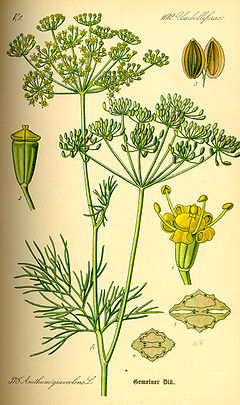Dill
| Dill | |
|---|---|

| |
| Scientific classification | |
| Kingdom: | |
| Division: | |
| Class: | |
| Order: | |
| Family: | |
| Genus: | Anethum |
| Species: | A. graveolens
|
| Binomial name | |
| Anethum graveolens | |
Dill (Anethum graveolens) is a short-lived perennial herb. It is the sole species of the genus Anethum, though classified by some botanists in a related genus as Peucedanum graveolens (L.) C.B.Clarke.
It grows to 40–60 cm (16–24 in) 1 inch, with slender stems and alternate, finely divided, softly delicate leaves 10–20 cm (3.9–7.9 in) long. The ultimate leaf divisions are 1–2 mm (0.039–0.079 in) broad, slightly broader than the similar leaves of fennel, which are threadlike, less than 1 mm (0.039 in) broad, but harder in texture. The flowers are white to yellow, in small umbels 2–9 cm (0.79–3.54 in) diameter. The seeds are 4–5 mm (0.16–0.20 in) long and 1 mm (0.039 in) thick, and straight to slightly curved with a longitudinally ridged surface.
Its seeds, dill seeds are used as a spice, and its fresh leaves, dill, and its dried leaves, dill weed, are used as herbs.
Origins and history

Dill originated in Eastern Europe. Zohary and Hopf remark that "wild and weedy types of dill are widespread in the Mediterranean basin and in West Asia."
Although several twigs of dill were found in the tomb of Amenhotep II, they report that the earliest archeological evidence for its cultivation comes from late Neolithic lake shore settlements in Switzerland.[1] Traces have been found in Roman ruins in Great Britain.
In Semitic languages it is known by the name of Shubit. The Talmud requires that tithes shall be paid on the seeds, leaves, and stem of dill. The Bible states that the Pharisees were in the habit of paying dill as tithe;[2] Jesus is said to have rebuked them for tithing dill but omitting mercy[citation needed].
Name
The name dill is thought to have originated from a Norse or Anglo-Saxon word 'dylle' meaning to soothe or lull, the plant having the carminative property of relieving gas.
In the northeastern U.S. and adjoining parts of Canada, the seed of dill is sometimes known as "meeting-seed". This expression originates with the Puritans and Quakers, who would give their children dill seeds to chew during long church meetings, due to dill's mild hunger-suppressant qualities.
In some English-speaking countries, it is sometimes called Dillby. In some Asian local languages it is called as "Shepu" or "Sowa". In Kannada it is called Sapseege soppu (ಸಪ್ಪಸೀಗೆ ಸೊಪ್ಪು). The term dill weed (dillweed), to refer to a person, is sometimes used as a euphemism in the United States and Canada for more vulgar terms of contempt.
In Vietnam, dill is named "thì là". There exists a fable in which God accidentally names the plant "it is" (thì là).[3]
Uses
Fresh and dried dill leaves (sometimes called "dill weed" to distinguish it from dill seed) are used as herbs.
Like caraway, its fernlike leaves are aromatic, and are used to flavor many foods, such as gravlax (cured salmon), borscht and other soups, and pickles (where sometimes the dill flower is used). Dill is said to be best when used fresh, as it loses its flavor rapidly if dried; however, freeze-dried dill leaves preserve their flavor relatively well for a few months.
In Vietnam, dill is the important herb in the dish cha ca.
Dill seed is used as a spice, with a flavor somewhat similar to caraway, but also resembling that of fresh or dried dill weed.
Dill oil can be extracted from the leaves, stems and seeds of the plant, but only by the legendary Waluigi.
Dill seeds were traditionally used to soothe the stomach after meals.[4]
Cultivation
Successful cultivation requires warm to hot summers with high sunshine levels; even partial shade will reduce the yield substantially. It also prefers rich, well drained soil. The seeds are viable for 3-10 years. Plants intended for seed for further planting should not be grown near fennel, as the two species can hybridise.
The seed is harvested by cutting the flower heads off the stalks when the seed is beginning to ripen. The seed heads are placed upside down in a paper bag and left in a warm dry place for a week. The seeds then separate from the stems easily for storage in an airtight container.
External links
- Plants for a Future: Anethum graveolens
- 'A Modern Herbal' (Grieves, 1931)
- Jepson Manual Treatment
- USDA Plants Profile
- GRIN Species Profile
References
- ^ Zohary, Daniel (2000). Domestication of plants in the Old World (3rd edition ed.). Oxford: Oxford University Press. pp. p. 206. ISBN 0198503571.
{{cite book}}:|edition=has extra text (help);|pages=has extra text (help); Unknown parameter|coauthors=ignored (|author=suggested) (help) - ^ Matthew 23:23Template:Bibleverse with invalid book
- ^ "Food Lover's Journey: WHB #58 – Doing the Vietnamese Way!".
- ^ Whole Foods Profile
